Pruning hydrangeas improves their shape, encourages new flowers, and increases the size of the blooms.
But if you’re doing it for the first time, you may be unsure about what time of the year to trim them and the techniques to use.
Luckily, it’s an easy skill to learn, and in this post I’m going to explain the process step by step and show you all you need to know.
By following my tips, you’ll learn how to prune hydrangeas the right way and keep your plants looking healthy and beautiful for years to come.
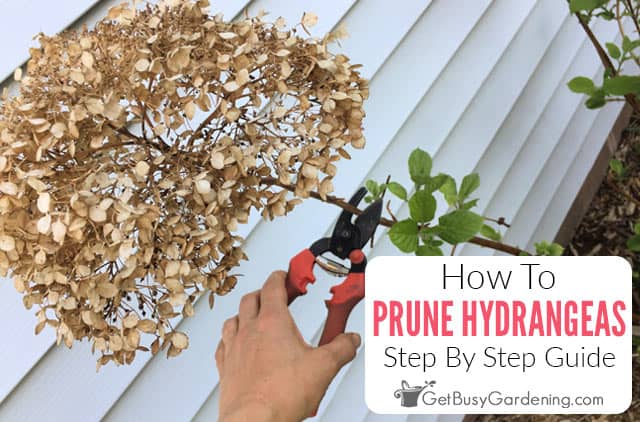
Do Hydrangeas Need To Be Cut Back?
If you want to keep your hydrangeas healthy and maintain a stunning display, I recommend pruning them regularly.
Removing damaged, dead, or diseased branches keeps them healthy, prevents them from getting tangled, and encourages new blooms to form.
Regular trimming also gives your shrubs a pleasing, balanced shape so they don’t become unwieldy and overgrown.
Why Prune Hydrangeas?
There are lots of good reasons to prune your hydrangeas on a regular basis. Here is a complete list of all the benefits of keeping them well-maintained.
- Encourages new growth – Trimming away dead or damaged branches invigorates your shrubs and promotes the development of fresh, new blooms.
- Controls the size – Hydrangeas can become quite tall and leggy without pruning, or they could end up outgrowing their space and crowding out nearby plants.
- Provides a balanced shape – Pruning can help create denser foliage and give your shrubs a more pleasing appearance.
- Prevents congestion – Branches that cross each other may become damaged from rubbing together, and flowers in these areas may be crushed or stunted.
- Keeps them healthy – Removing dead or unhealthy stems and foliage helps to prevent issues with diseases, fungus, and pests.
Related Post: How To Grow Hydrangeas: Complete Care Guide
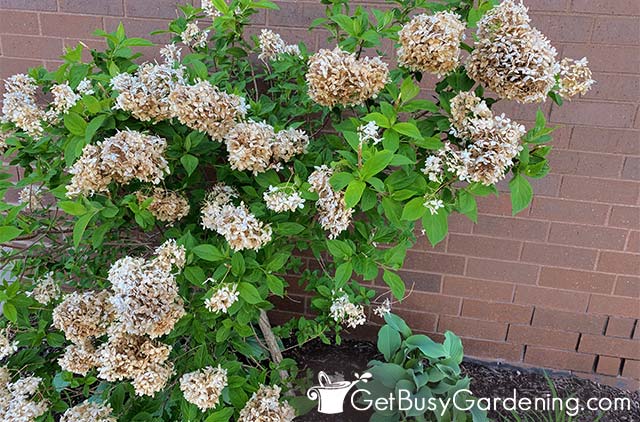
When To Prune Hydrangeas
To determine exact when to prune your hydrangeas, you first need to establish whether your bush flowers on old or new wood.
Shrubs that flower on old wood will generally bloom in the spring, then fade sometime in mid summer. You should trim these varieties after they have flowered.
Hydrangeas that flower on new growth tend to bloom from late summer to fall. Prune these varieties after the shrub goes dormant in late fall, or before it comes out of dormancy in early spring.
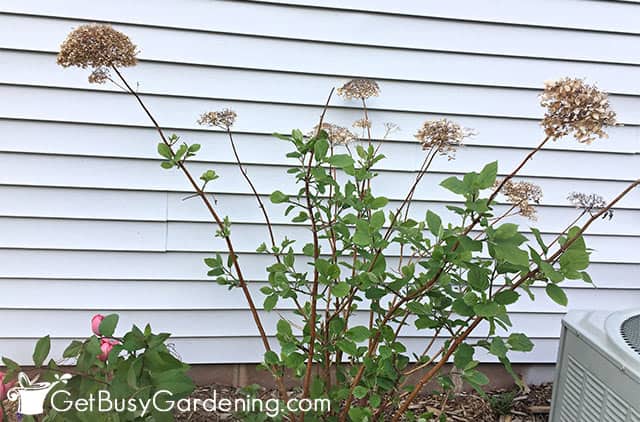
Tools For Trimming Hydrangeas
You can use regular pruning shears to trim hydrangeas or heavy-duty pruners for particularly woody stems.
If your shrub is large, hedge shears, an electric hedge trimmer, or a hand saw can make the job easier. You may also find a lopper useful for reaching down inside the plant or removing thick branches.
Before you start pruning, make sure your tools are clean and sharpened. This will give you precise cuts that heal quickly without damaging the plant.
Techniques For Pruning Hydrangeas
There are three techniques you can use to prune hydrangeas. You can trim back stems and branches, remove the dead or fading blooms, or cut the shrub all the way down to the ground.
Trimming Back Stems & Branches
You might need to remove stems or branches from your hydrangea if they’re dead or dying, growing at irregular angles, or because the shrub is congested.
Remove shriveled, brown tips by cutting back to the next healthy set of leaves or buds. Trim dead branches all the way to the base of the plant.
Make your cuts at an angle, just above and away from the node. Be careful never to prune more than one-third of a healthy stem at a time.
Deadheading Hydrangeas
You can deadhead your hydrangeas as the blooms begin to fade. Removing the spent blossoms makes the plant look tidier, and also encourages new flowers to open.
Using sharp, clean pruning shears, simply snip off the flower and its stem to a point immediately above the next set of leaves.
Some gardeners, however, choose not to deadhead their shrubs. This won’t harm them, and it means they will still look attractive in the garden during the winter months.
The dead flowers can also help protect the plant from being damaged by extreme temperatures during a harsh winter.
Cutting Hydrangea Down To The Ground
Most hydrangeas are deciduous and can be cut all the way to the ground without any harmful effects. This can be a convenient alternative to pruning if you have lots of plants and little time.
It’s also a good way to gain back control of an extremely overgrown shrub or rejuvenate one that’s been neglected for many years.
They won’t be as large or full next season, however, so I don’t recommend doing it if you want to preserve the size of your plant.
If you choose to prune them all the way back, the best time to do it is in late winter or early spring before new leaf buds form.

Hydrangea Pruning Tips
Pruning is the best way to keep your shrub healthy, and improve the appearance of a leggy or overgrown hydrangea. Here are the techniques to use for the best results.
Pruning A Leggy Hydrangea
Over time hydrangeas can become tall and leggy, giving them an unhealthy look, and exposing bare wooden stems that spoil their appearance.
Cutting back the long, spindly stems will give them a fuller, more balanced look, and encourage branching.
Hydrangeas are very forgiving when it comes to pruning, but it’s a good idea to decide ahead of time which parts to cut.
Step 1: Remove any dead or damaged stems – Trim away any brown or shriveled branches down to the next set of healthy leaves, or all the way to the base if they’re dead.
Step 2: Trim back the longest branches – Trim the longest branches back by one-third of their length, making clean cuts at 45-degree angles just above a pair of healthy buds or leaves on each stem.
Step 3: Look for droopy or curved stems – Some stems get so long that they begin to droop or curve, so trim those back next.
Pruning An Overgrown Hydrangea
If your hydrangea bush has become huge and overgrown, pruning will restore its balanced appearance, and ensure that it thrives.
You can remove any dead or dying leaves and branches, too, which will divert the plant’s energy to new growth.
Step 1: Remove all dead leaves and branches – This will tidy things up and give you a clearer picture of your shrub’s overall shape.
Step 2: Locate dying or damaged stems – Trim dead or damaged branches back to the points at which they’re healthy.
Step 3: Step back and assess your progress – Consider the shape you’re aiming for and use string to mark the parts you want to prune.
Step 4: Trim to a balanced shape – Continue to prune carefully, standing back between cuts to see how you’re doing. This will prevent you from trimming off too much in one area and giving your bush a lopsided look.
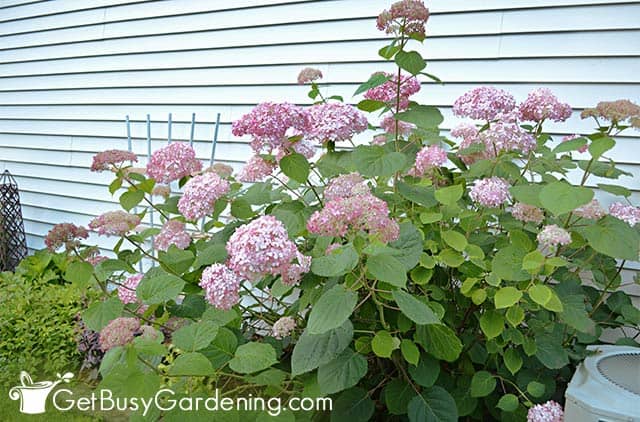
FAQs
Here I’ll answer the most common questions I receive about pruning hydrangeas. If you don’t see yours listed, please ask in the comments section below.
Do hydrangeas need to be cut back for winter?
Hydrangeas don’t need to be cut back for winter. In fact, many gardeners like to leave the dried flowers on the plant for winter interest in their garden.
Do you cut back hydrangeas in the fall or spring?
You should cut back hydrangeas that flower on new wood in either the late fall or early spring. Prune the varieties that flower on old wood immediately after their blooms have faded, sometime in mid to late summer.
What happens if you don’t prune hydrangeas?
If you don’t prune hydrangeas they may get tall and leggy over time, or the branches could become tangled and unhealthy. They may also produce smaller, less impressive blooms.
When is it too late to cut back hydrangeas?
It is too late to cut back hydrangeas that bloom on new wood once they start leafing out in late spring, as you risk removing flower buds. Hydrangeas that flower on old wood need to be cut back immediately after they have stopped blooming.
Do you cut off hydrangea blooms when they turn brown?
It is safe to cut off hydrangea blooms when they turn brown, and many people do this to keep the shrubs looking attractive. But it isn’t necessary, and leaving dead flowers on will not affect the health of the plant.
When should hydrangeas be pruned?
Hydrangeas should be pruned immediately after they have stopped blooming if they flower on old wood. Otherwise, prune them in late fall or early spring.
More About Pruning Plants
- How To Prune & Trim Roses
- How To Trim Tree Branches Yourself
- How To Prune Russian Sage
- Pruning Plants: The Complete Step-By-Step Guide
Share your tips for how to prune hydrangeas in the comments section below.
Step By Step Instructions
How To Prune Hydrangeas Step By Step

Learn how to prune hydrangeas with my step-by-step instructions. Discover my tips for success, including how to determine exactly when to trim them, as well as the best techniques and tools to use.
Instructions
- Deadhead the flowers - Using sharp, clean pruning shears or hedge trimmers, snip off the flowers and their stems.

- Find the next set of leaves or buds - Locate the next set of leaves or emerging green buds below the point where you want to cut the stem.

- Remove dead branches - Trim dead branches down to just above the first set of leaves or buds, or all the way to the base of the plant. Use heavy-duty pruners for thick branches.

- Prune out damaged stems - Remove any diseased or damaged stems by trimming back to the next healthy leaves or buds, cutting at an upward angle.

- Remove any crossing/entwined branches - Look for tangled or crossing branches and cut them down to the ground.

- Check your progress - Stand back often and assess your work to ensure you don’t cut off too much in one area.
- Shape the shrub - Continue to prune, stepping back frequently to check your progress, until you have achieved your desired shape.
Notes
- Always make sure your tools are sharp and clean before pruning hydrangeas. Dull, dirty tools can damage the plant or introduce disease.
- Never remove more than ⅓ of the healthy foliage at one time or your bush may struggle to recover.
- You can cut your shrubs all the way to the ground, but they won’t be as full or as large the following season.
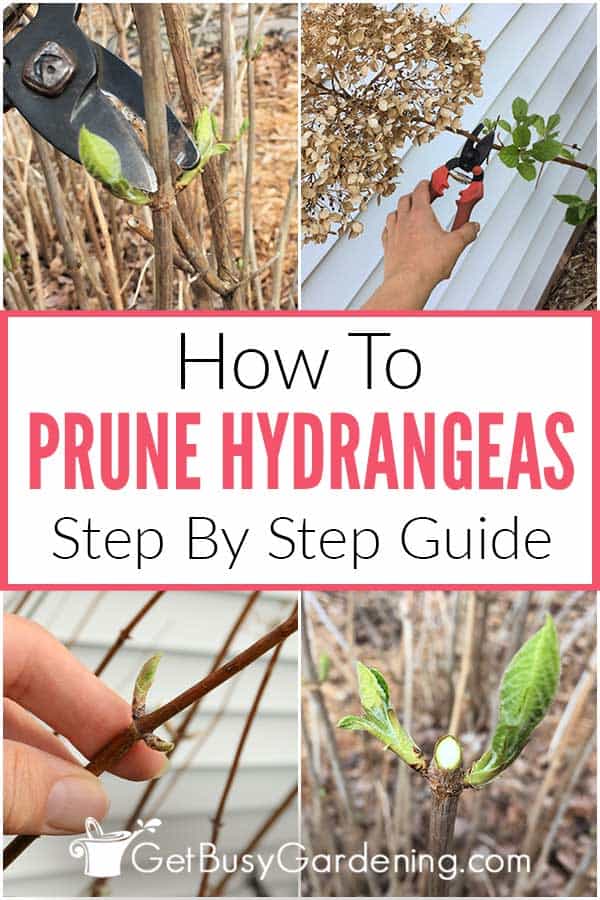



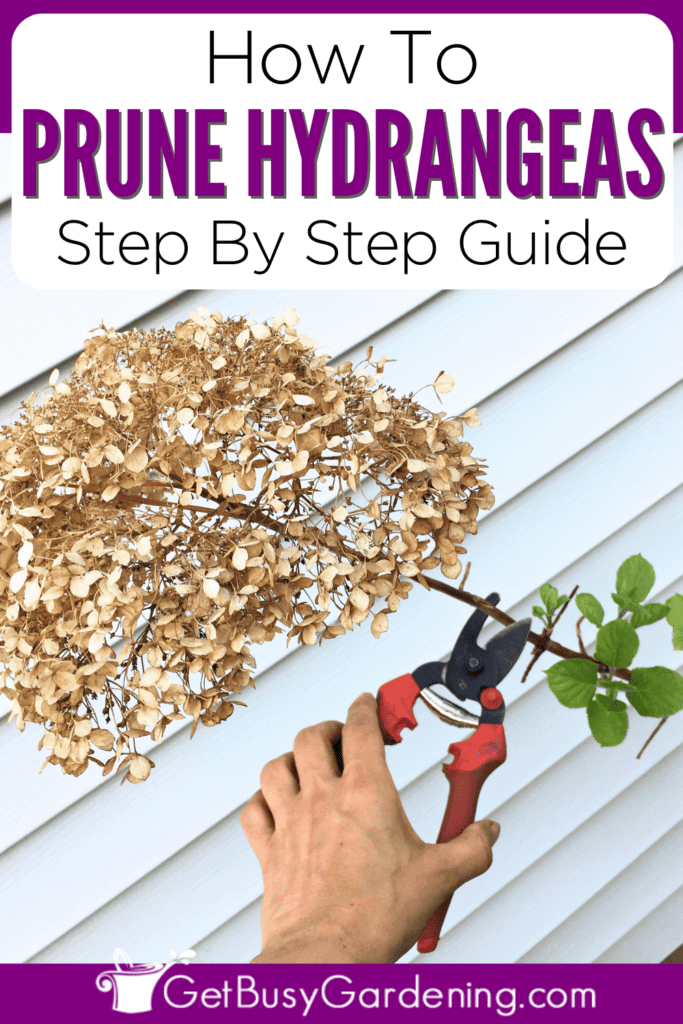
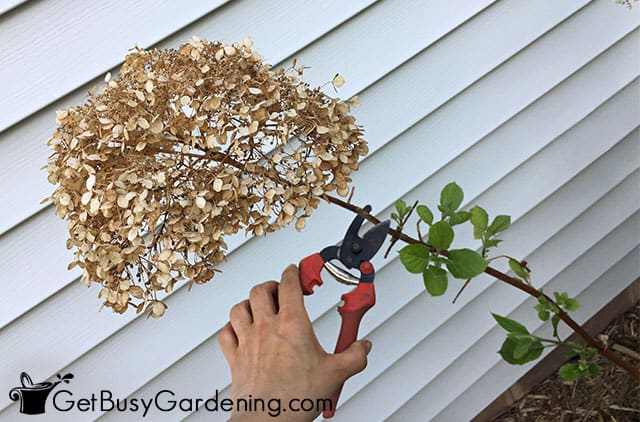


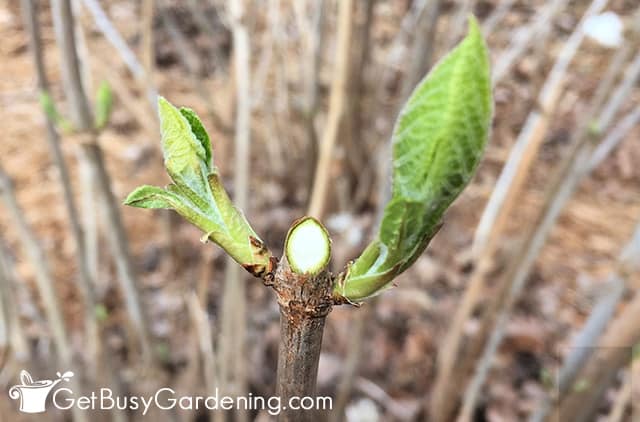
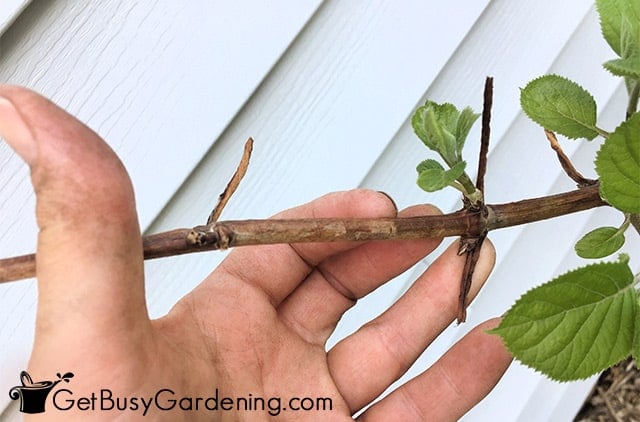

lillie rucker says
just learning and very helpful. thanks
Amy Andrychowicz says
You’re welcome! 😊
Jerry T says
I have Endless Summer which blooms on Old wood as well as New wood. What’s the best way to prune and time of year?
Amy Andrychowicz says
Wait until spring to prune your Endless Summer hydrangeas. Once you see new leaves starting to sprout, then cut back the dead wood only. If you want to prune them for shape or size, then wait until after the flowers fade in the summer.
Jean Bates says
How about Snowball hydrangea?
Mine have stayed green heads this year.
Only a few are white large balls this year.
Became quite wide in ground area.
Staked up with shorter fencing looks good.
Should I cut them to the ground this year?
Amy Andrychowicz says
Snowball hydrangeas bloom on new wood, so you can prune them either in the fall or in the early spring. Whether you cut them down to the ground or not is your choice. If you do, it will take a year or two for them to fully fill back in, and they may not bloom as well next year. But it is a great way to rejuvenate a large, overgrown shrub! And it’s not uncommon for the flowers to stay green, this can happen sometimes. It can be caused by too much shade, so maybe your shrub is getting less light than it used to? Otherwise, don’t worry about it, sometimes it’s just a weird weather year, or some other unknown factor, and they’ll go back to being white once things go back to normal.
Jean Bates says
Appreciated your “to the point” hydrangea advise!
The photos were very helpful too and not overdone.
My 3 plants (2 are younger but of the same sort) are a joy to see.
They are heavy with blooms and need lower pruning for ground clearing.
Any suggestions as to that area?
Agree with the pruning of crossing or heavy lengths.
Love bringing in and drying for decorating. How to keep the color inside would be appreciated too. The burgundy color lasts years.
Thanks for your help.
Amy Andrychowicz says
You’re welcome, glad you found my guide helpful! You can prune back the lower branches of your hydrangea to clean things up at any time, especially if they don’t have flowers on them. Cut the dead or dying ones all the way down to the main stem or the base of the shrub.
The dried flowers won’t retain the same vivid color they have in the garden, it will always be more muted. But to get the best possible color, let the flowers dry partially (but not all they way) on the plant, then cut them off, remove all the leaves, and put them in a vase of very shallow water (only 1-2″ deep). Drying them in water will help preserve the color better, as it slows down the process.
Lydia Moore says
I have a hydrangea planted this year in the spring. Should I prune it this fall or wait until next fall.
Also planted a Vanilla Strawberry hydrangea about a month ago, August. It’s about 2′ tall, no blooms, and I’m guessing it doesn’t need to be pruned.
Thank you for this informative article. It’ll help me take better care of my exiting hydrangeas
Amy Andrychowicz says
Whether you prune your hydrangea in this fall or next spring depends on if it blooms on now or old wood. Vanilla Strawberry blooms in new wood, so you could prune it either this fall or wait until spring. And yes, your brand new hydrangea does not need to be pruned.
Lynn says
Very few blooms what am I doing wrong?
Amy Andrychowicz says
There are many reasons why your hydrangea might not be blooming, and pruning at the wrong time is a common one. First you need to determine if your shrub flowers on old or new wood, then you’ll know when to prune it. If you trim it back at the wrong time of the year, you could be cutting off the flowers. Here’s my complete care guide for more details.